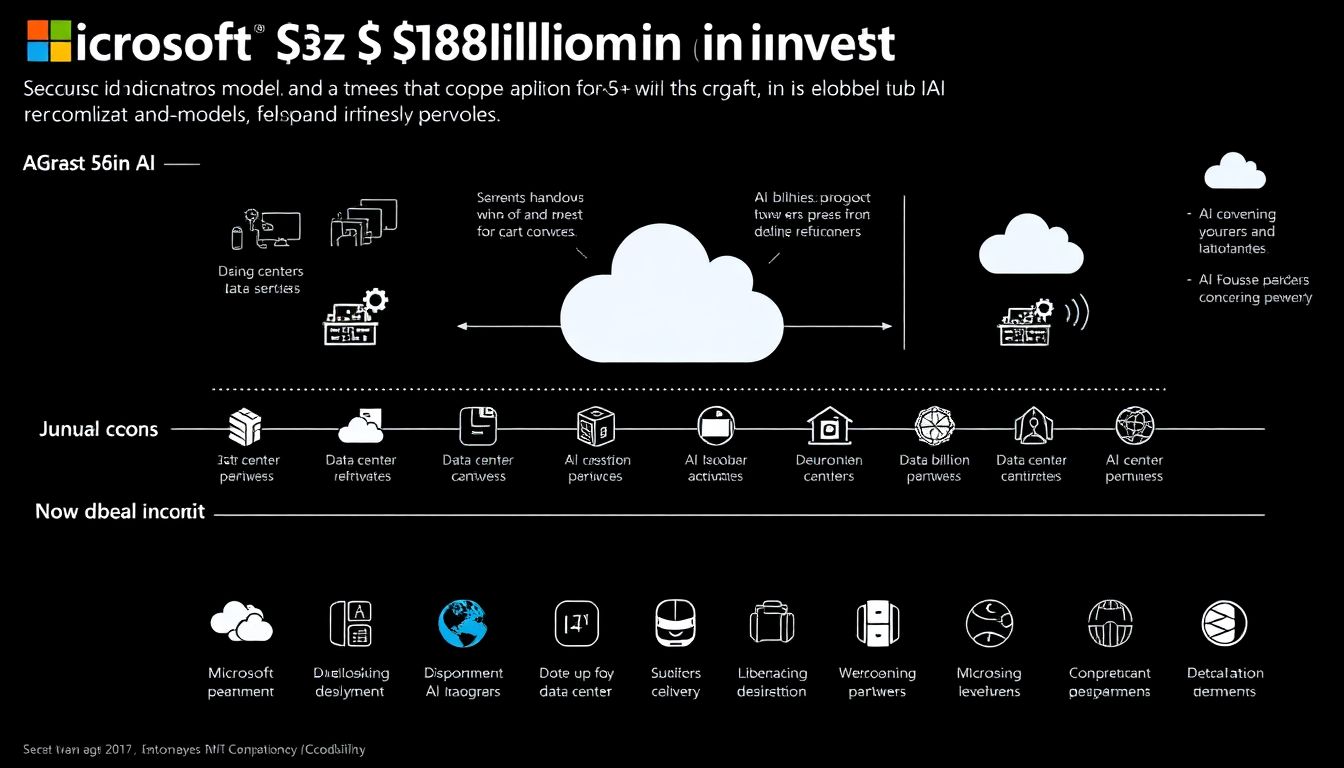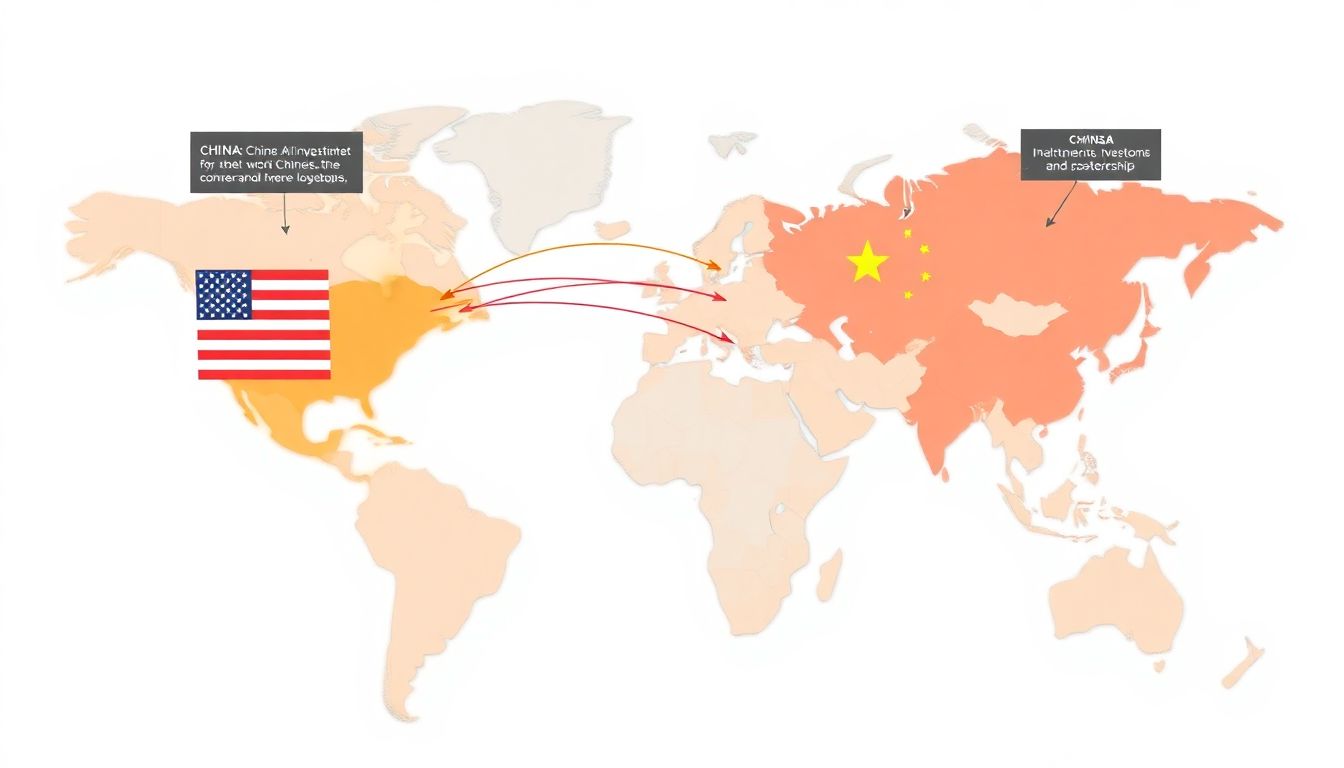In a significant announcement, Microsoft President Brad Smith revealed the company’s ambitious plans to invest a staggering $80 billion in artificial intelligence (AI) this fiscal year. This move underscores Microsoft’s commitment to leading the global AI race and highlights the transformative potential of AI across various aspects of life. Smith’s call for increased support and strategic international partnerships emphasizes the urgency and importance of AI innovation for the United States. Let’s delve into the details of Microsoft’s AI investment and its broader implications.
Exploring Microsoft’s ambitious AI investment and its implications for the global tech landscape.
The illustration presents a panorama of a futuristic cityscape, with Microsoft’s logo conspicuously integrated into the scene, suggesting a significant influence of the tech giant in this imagined future. The landscape is a bustling ecosystem of AI-driven technologies, with self-driving cars cruising along sleek roads, smart homes dotting the skyline, and advanced robotics performing various tasks. The scene is not merely a fantastical dream but a plausible extrapolation of current technological trends, where AI and automation play a central role in everyday life.
The connective tissue of this futuristic tableau is a vast network of data centers, implied to be powered by Microsoft’s technologies. These data centers are not merely passive infrastructure but active facilitators, enabling the seamless integration and communication of various AI-driven technologies. The illustration posits a future where data is the lifeblood of urban life, and companies like Microsoft are the cardiovascular system that keeps it flowing. However, it also raises important questions about data privacy, corporate influence, and the potential digital divide in such a hyper-connected world.

Microsoft’s AI Investment: A Breakdown
Microsoft’s ambitious plan to invest $80 billion in AI and cloud computing is a strategic move that underscores its commitment to leading the tech industry’s next big wave. A significant portion of this investment is earmarked for the construction of AI data centers. These data centers, designed to be environmentally sustainable, will bolster Microsoft’s Azure cloud infrastructure, ensuring that it remains competitive with rivals such as Amazon Web Services and Google Cloud. By expanding its data center footprint, Microsoft aims to enhance its capacity to handle vast amounts of data and support increasingly complex AI workloads. Furthermore, these data centers will be strategically located to meet the growing demand for cloud services worldwide, reducing latency and improving performance for users.
In addition to infrastructure, Microsoft is dedicating a substantial part of the investment to training AI models. This involves several key initiatives:
- Developing more sophisticated AI algorithms that can understand and generate human language, a critical component of Microsoft’s vision for future productivity tools.
- Advancing AI capabilities in computer vision, speech recognition, and decision-making processes.
- Investing in responsible AI initiatives to ensure that models are fair, transparent, and respect user privacy.
These investments align with Microsoft’s long-term strategy to integrate AI into every aspect of its product offerings, from Office 365 to LinkedIn, enhancing user experiences and driving innovation.
The third prong of Microsoft’s investment strategy involves deploying cloud-based applications. This includes expanding the capabilities of Azure AI and Microsoft 365, enabling businesses to leverage AI for insights, automation, and customer engagement. Key areas of focus include:
- Enhancing Azure AI services to provide developers with advanced tools for building, training, and deploying AI models.
- Integrating AI into Microsoft 365 to create more intuitive, personalized user experiences.
- Developing industry-specific AI solutions for sectors such as healthcare, finance, and retail.
However, while these investments promise significant advancements, they also present challenges. These include managing the environmental impact of data centers, addressing potential job displacement due to automation, and ensuring that AI is used responsibly and ethically. Microsoft’s willingness to engage with these challenges reflects its commitment to a balanced and thoughtful approach to technological progress.

The Global AI Race: US vs. China
The competition between the United States and China in the realm of artificial intelligence (AI) is intense and multifaceted, with both countries employing distinct strategies to gain a competitive edge. The U.S. has traditionally led in AI development, thanks to its robust ecosystem of tech giants, cutting-edge research institutions, and a strong startup culture. The U.S. strategy has focused on fostering innovation through public-private partnerships, investing in AI research and development, and attracting top global talent. Meanwhile, China has rapidly emerged as a formidable contender, with a state-led approach that prioritizes AI as a strategic national initiative. China’s strategy includes:
- Generous government funding for AI research and development.
- Ambitious data collection and aggregation efforts.
- Subsidized computer chips and AI data centers offered to developing countries.
This approach not only accelerates China’s domestic AI capabilities but also expands its global influence through tech diplomacy.
China’s offer of subsidized computer chips and AI data centers to developing countries is a strategic masterstroke with both positive and negative implications. On the positive side, it democratizes access to advanced technology, empowering developing countries to leapfrog traditional stages of technological development. It also fosters international collaboration and creates new markets for Chinese tech companies. However, there are significant concerns to consider. Such subsidies can lead to:
-
Debt-trap diplomacy:
Recipient countries may become dependent on Chinese technology and financing, leading to long-term economic and political leverage.
-
Data security and privacy risks:
The transfer of sensitive data to Chinese-controlled data centers can pose significant security and privacy challenges.
-
Geopolitical tensions:
The strategy may exacerbate tensions with the U.S. and other countries wary of China’s growing influence.
To counter China’s strategic advances, the U.S. needs a smart international strategy that emphasizes the importance of international partnerships. This strategy should include:
- Promoting open and transparent AI development standards.
- Investing in AI infrastructure and talent development in allied and partner countries.
- Strengthening international cooperation on AI ethics, governance, and security.
By fostering a network of like-minded nations committed to responsible AI development, the U.S. can maintain its competitive edge while promoting a more equitable and secure global AI landscape.

The Future of AI: Opportunities and Challenges
The AI landscape is burgeoning with potential opportunities, poised to transform various industries and aspects of life. AI can revolutionize healthcare through personalized medicine, early disease detection, and improved patient outcomes. In finance, AI can enhance fraud detection, risk assessment, and algorithmic trading. Meanwhile, in transportation, autonomous vehicles and smart traffic management systems promise increased efficiency and safety. Furthermore, AI can tackle complex challenges like climate modeling and sustainable resource management. However, these opportunities come with significant challenges.
Government and private sector investments play a pivotal role in driving AI innovation. Public funding can catalyze research and development, fostering advancements in AI algorithms, infrastructure, and applications. Meanwhile, private sector investments can propel entrepreneurship and commercialization, ensuring that AI solutions reach the market. Notably, public-private partnerships can amplify these effects, creating a robust ecosystem for AI innovation. Nevertheless, balancing these investments with ethical considerations and equitable access to AI benefits is crucial.
Ethical considerations and potential risks associated with AI development must be at the forefront of the conversation. Key concerns include:
-
Bias and Fairness:
AI systems can inadvertently perpetuate or even amplify existing biases present in their training data. Ensuring fairness and accountability in AI decision-making is paramount.
-
Privacy:
AI’s hunger for data can infringe on individual privacy rights. Striking a balance between data utility and privacy protection is a pressing challenge.
-
Transparency and Explainability:
Many AI models operate as ‘black boxes,’ making it difficult to understand their decision-making processes. Developing explainable AI systems is essential for accountability and trust.
-
Job Displacement:
Automation driven by AI could lead to job loss in certain sectors. Proactive policies are needed to mitigate these impacts and facilitate workforce transitions.
-
Autonomous Weapons:
AI’s role in defense and security raises grave concerns about the development and use of autonomous weapons, necessitating international dialogue and regulation.
Navigating these risks requires a multi-stakeholder approach, involving governments, civil society, and the private sector.
FAQ
Why is Microsoft investing so heavily in AI?
How does the competition between the US and China in AI impact the global tech landscape?
What steps can the US take to maintain its leadership in AI?
- Increase funding for AI research at universities and the National Science Foundation.
- Develop a smart international strategy to promote American AI technologies globally.
- Enlist allies to support and advocate for US AI technologies as superior and more trustworthy.
